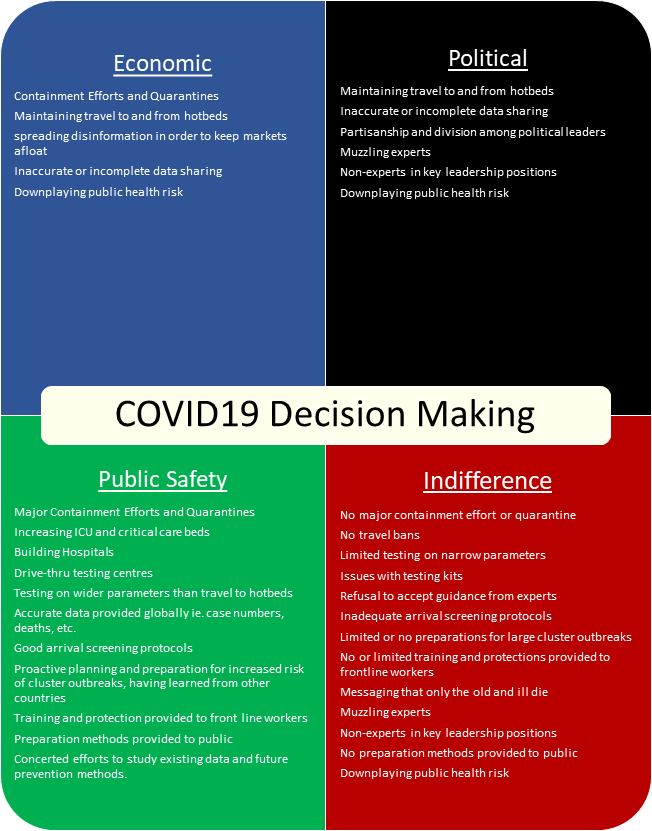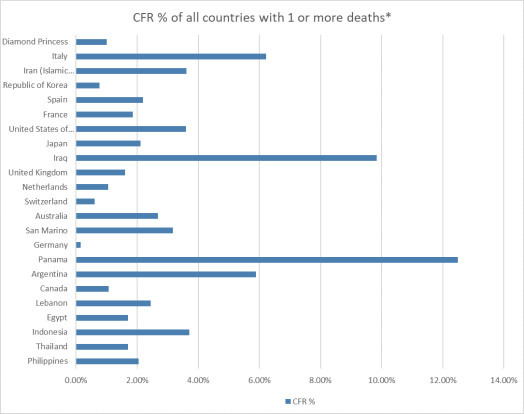Policy makers, governments, and political leaders are making decisions everyday in the management of the COVID-19 crisis. The decisions they make greatly affect the outcomes and your chances of being infected with the disease. And each country seems to be approaching each decision from a different desired outcome.
News of wider community spread is being seen in several countries including the United States. Yet there are many variables as to why spread appears to be rampant in some countries, why the number of confirmed cases is much higher in some countries and why the mortality rate differs across countries.
The important thing is, you want to understand what your personal risk is. First it’s important to understand the risk is two-fold. One is the risk of contracting the virus. The second is the risk of dying from the virus.
Risk of Contracting COVID19
Countries appear to be making their decisions along four quadrants, Economic, Political, Public Safety, and Indifference. I have assigned the decisions along these quadrants based on my own analysis and assumptions. My analysis is based on the reading of various articles both evidence-based scientific papers as well as news media and experts’ opinion.
If your country is making decisions based largely on indifference, political suitability or economics then you are at higher risk. If your country is making decisions largely on public health and safety that would naturally lower your risk.
Keep in mind that countries are making decisions based on a variety of factors and these factors may fall into multiple quadrants, but if your federal and local government is making decisions based largely on indifference then your risk increases greatly.
The following chart outlines the types of decisions being made and the quadrant each decision falls into. Where does your country fall? That’s the first step in assessing both risk of contracting COVID19 as well as the risk of dying from COVID19.

Next is to understand the risk variables. The following table outlines some of the variables and how your personal risk of contracting COVID19 increases or decreases based on a variety of factors. At this time there is no algorithmic quantification for risk because there are many variables, some variables are random, and the world is still learning how the virus behaves, but you can use this table as an assessment tool.
| Personal Risk Variable of contracting COVID19 | Higher Risk + | Lower Risk – |
|---|---|---|
| The country you live in | + Countries making decisions based on Indifference | – Countries making decisions based on public safety |
| Travel | + Travel to a hotbed or contact with someone who did increases risk | – No travel reduces risk |
| Number of people who live in your household | + The more people in your household increases your risk | – Living alone means your risk is reduced |
| Number of people you encounter | + Risk increases with increased human interaction | – Less human interaction reduces risk |
| Your occupation | + Frontline health care workers or working with the public in any occupation increases risk | – Working from home is the lowest risk |
| Your level of knowledge on precautions | + Unknowledgeable about spread, handwashing, symptoms, masks etc. increases risk | – lower your risk by arming yourself with evidence-based knowledge. Follow the guidance of experts. |
Risk of Dying from COVID19
Next is the assessment of risk related to mortality.
For accurate assessment of the situation and to understand the Case Fatality Rate (CFR), you must have an accurate number of confirmed cases. Based on data from the World Health Organization’s Situation Report 51, dated Mar 11, 2020, the CFR in the United States is 3.59% based on 696 cases and 25 deaths. This is much higher than France, as an example, that has a 1.86% CFR based on 1,774 cases and 33 deaths. While Morocco is at a 33.33% CFR because they have reported 3 confirmed cases and 1 death. Morocco has been removed from the following chart.

The CFR is dependent on multiple variables. Some of these include the level of care provided, availability of medical equipment, the demographic of the infected patient, the medical history of the infected patient, containment and mitigation measures employed and enforced by local and federal governments. Of course having accurate data is critical to assessing the risk on mortality.
“it’s difficult to build a global picture in real time if we do not have the right data in real time from all countries.” – Dr. Michael J. Ryan Executive Director WHO Daily Briefing on Covid-19 (Mar 9, 2020)
An additional caveat is having widespread testing based on wider parameters than travel to a hotbed, we are past that point. In the United States testing has been badly mishandled. Political and ideological differences only add to the threat that is just beginning to unfold in the United States.
The following is a risk assessment tool for mortality.
| Personal Risk of Mortality with COVID19 | Higher Risk + | Lower Risk + |
|---|---|---|
| The Country you live in | + The quadrant your country falls into for decision making. Highest risk if in the Indifference quadrant | – Decisions made based on Public Safety lower your risk |
| Your Age | + over 80 highest age risk. Over 60 still high risk. | – Under 20 lower risk |
| Your Health History | + underlying health conditions such as heart conditions, lung conditions, diabetes, cancer | – No underlying health conditions |
| Availability of health care and medical equipment | + Lack of ventilators, medical staff, ICU beds will all increase your risk | – Ample medical equipment and medical staff lower your risk |
| Containment Measures | + Wider spread means that more people get sick at once and require medical intervention at the same time. This increases your mortality risk | – A country that employs swift and strong containment measures means the need for hospital intervention is spread out, therefore reducing your risk of dying as medical care and availability improves |
Containment measures allow a country to cope with the management of medical care. Too many people needing medical care at once means less equipment to go around. This is when difficult decisions will be made by frontline medical staff. Imagine a scenario where there are not enough ventilators for the number of serious cases. Our best bet is to “flatten the curve”, this elongates the timing of the spread, and reduces the burden on the medical system, which increases survivor rates.
The following is an impressive graphic by Alexander Radtke (chart creation) and Prof. Dr. Benhur Lee (Label clarification). It shows how we can flatten the curve of cases to reduce burden on the medical system.
The biggest risk as we all know by now is age and comorbidity, “The virus that causes COVID-19 infects people of all ages. However, evidence to date suggests that two groups of people are at a higher risk of getting severe COVID-19 disease. These are older people (that is people over 60 years old); and those with underlying medical conditions (such as cardiovascular disease, diabetes, chronic respiratory disease, and cancer). The risk of severe disease gradually increases with age starting from around 40 years. It’s important that adults in this age range protect themselves and in turn protect others that may be more vulnerable.” WHO Situation Report 51 Mar 11, 2020
What you can do
Your best advantage is to manage your emotions as we move through the phase of spread. Here are some tips on how to do that. At the same time manage your risk. Understand what increases your risk of contracting COVID19 and your risk of dying from COVID19, using the information in the tables above, and of course seek out new and additional information from credible sources.
Remember to check the sources of information. Do not fall prey to cures and treatments that don’t make medical sense, no matter how desperate you become. Although the internet is rife with all kinds of disinformation on cures and prevention, there is no cure or medical prevention at this time. There are simple common sense things you can do, and there are medical interventions to help you cope and survive.
If you have elderly relatives living in a communal nursing home environment with other seniors, do not visit. Because the virus can be transmitted asymptomatically it is best to err on the side of caution. And any large gathering is a no-no at this time.
Of course do all the things recommended by experts, washing hands, limited social contact, increased social distancing. Even simple things like not eating with your hands, washing home entry doorknobs, spraying your Amazon packages with a disinfectant, may help.
You can take these and more steps towards reducing your personal risk in contracting COVID19. Know the risk factors for both contracting and mortality to help reduce your chances of becoming a statistic. Share this article with those you care about, using the social links below. And let’s all help each other get through this.



Excellent presentation and an interesting approach.
I found being in town today (UK) – at the quietest time I could find – an alarming experience, due to the utter indifference and carelessness of everyone.
No masks, no gloves, no distancing….
Even an old man trying to buy hand sanitiser in the supermarket said that it was ‘all a fuss over nothing.’
Overheard people saying ‘it would go in the summer’ -which by the way doesn’t come until August in England, if one is lucky!
I have never so much wanted to be 20 again, cocooned in near-invulnerability…..
LikeLiked by 1 person
Thanks for sharing your thoughts Xavier. And appreciate your encouraging words. I agree with you on carelessness. This is brought about by a mindset based on misinformation and disinformation, some of it purposeful. Being under 20 is definitely a benefit when it comes to mortality rates, but they could be super spreaders, if they do not accept the devastating effects this pandemic will have. Knowledge is paramount. The UK appears to be on the same trajectory as the US. Perhaps cocoon yourself in your home. I like the word you chose, it’s better than isolation. Thanks very much for reading! Pleasure to meet you, virtually of course. 😃
LikeLiked by 1 person
Sorry Xabler, just realized I called you Xavier. Haste makes waste. Mea culpa!
LikeLike
wonderful job outlining and explaining the risks without bringing emotion into the picture. hope you are staying healthy, Shelley!
LikeLiked by 1 person
Thank you Jim! Appreciate your words. Trying my best to stay that way. Hope you and your family do as well as you make your way here. My advice – stay there!
LikeLiked by 2 people
we have seriously thought about it; but are concerned there may be further travel restrictions and then we could be here for a while…
LikeLiked by 1 person
Agreed. That really presents a problem.
LikeLiked by 1 person